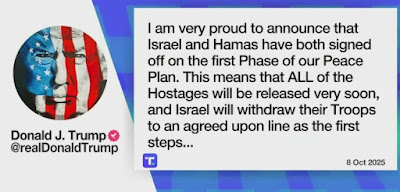
In a whirlwind of activity in the Middle East that has resulted in the success of the Trump plan for what appears to be a permanent ceasefire in the Israel-Hamas war in Gaza, one has to wonder about the thought process on the Hamas side that led to the agreement.
The question most of those of us who specialize in the Middle East are asking is, “Why would Hamas agree to give up what is their ace-in-the-hole during the entire two year confrontation, the Israeli hostages*?”
The hostages were all that was preventing the Israelis from going what we Christians would call “Old Testament” on Hamas. If they had not had these “detainees,” I believe that the Israel Defense Forces would have laid waste to the entire Gaza Strip.
For those not familiar with the geography, the Gaza Strip is about 25 miles long and seven miles wide, home to about 2.3 million people. We do not have good number on how many of them support Hamas, but at one point, 70 percent of Gazans supported the attacks of October 7, 2023.
That has since declined as the IDF has turned the area into the rubble that resembles Dresden in 1945, but the remaining level of support for the group that is responsible for creating one the greatest humanitarian crises in modern times is astounding.
Let’s go back to the agreement between Hamas and Israel. I understand the pressure applied on Israel by President Donald Trump and other world leaders. What I remain curious about is the pressure applied on Hamas – and it was there – from Qatar, Egypt, and Turkey. I believe that it was the pressure from Turkey that may have carried the day.
It is no secret that Turkish President is an avowed Islamist, a behind-the-scenes supporter of both Hamas and the Islamic State – after all, how did all those ISIS fighters get into Syria and Iraq? I have spent a lot of time on both sides of the border between Turkey and Syria. It is a serious border, especially on the Turkish side, complete with fencing, lighting, guard towers, and minefields. ISIS fighters crossing from Turkey into Syria had to have assistance – either bribery, government collusion, or both.
As is the case with many countries in the Arab and Muslim worlds, Turkey has been a political and diplomatic supporter of Hamas. Turkish President Recep Tayyip Erdoğan has defined Hamas as liberation movement. Even after the October 7, 2023 massacre, he was quoted as saying, “Hamas is not a terrorist organization, it is a group of mujahidin (holy warriors) defending their lands.”
Why was Turkey at the talks?
My take on this is that most of the Arab and Muslim world, and now likely including Turkey, is suffering from “Palestinian Exhaustion.” In other words, they are tired of the Palestinians in general, and Hamas in particular. Even countries that had previously supported the Palestinians — some even condoning the violence of October 7 — have watched for two years as Israel destroyed virtually the entire infrastructure of the Gaza Strip, with no indication that Prime Minister Benjamin Netanyahu intended to stop before Hamas was completely eradicated.
I suspect that the leadership of Egypt, Qatar, and Turkey informed what is left of the leadership of Hamas that it was time to stop the fighting. At last count, according to the Palestinian Ministry of Health, the death toll in Gaza is over 67,000 with almost 170,000 injured, and as many as 11,000 missing (believed to be under the rubble). Hamas has lost most of its senior leadership inside and outside of the Gaza Strip, civilian casualties continue to mount, and there was no possible path to any sort of meaningful victory.
The Trump plan, among other things, calls for the immediate return of the 48 hostages (only 20 of whom are thought to be alive), phased withdrawal of Israeli forces from the Strip, and the disarming of Hamas. Hamas is still refusing to disarm.
I am surprised that Hamas has agreed to release the remaining hostages in the first phase. While the Israelis have begun the initial phase of their withdrawal, they are still in Gaza with overwhelming military force. Once the hostages are released, Hamas’s leverage is gone. It was their sole bargaining chip. Hamas will now have to rely on whatever security guarantees were made by the negotiating parties in Sharm al-Shaykh.
Hamas realistically had no choice. Support for Hamas in the Arab and Muslim world was declining, the Israelis were relentlessly pursuing Hamas members in the last bastion of Gaza City, and even the hard-core could see that it was only a matter of time before they would be all killed or captured.
___________
* When the international press referred to the Israelis taken on October 7 as “hostages” – the Arabic word is (رهائن – raha’in), most of the Arabic media was offended. They refer to those taken as “detainees” (محتجزين – muhtajazin), which must be some lesser category. When I was the interpreter for the U.S.-Iraqi talks at the end of Desert Storm, this was the agreed-upon word for Kuwaiti prisoners. The Iraqis had referred to them as “guests”( ضيوف – dhiyuf) until I officially objected.


